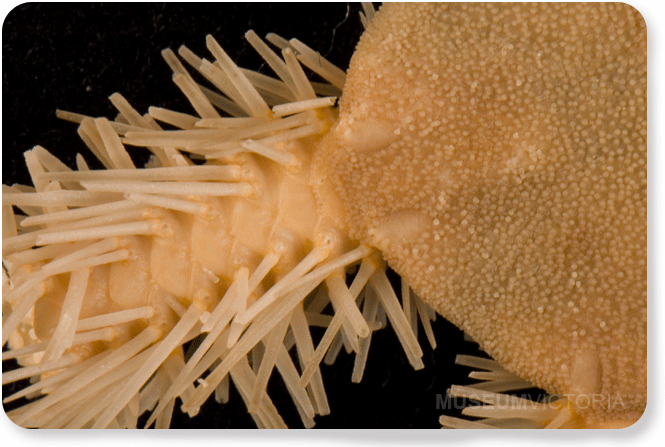
Home -> Species index -> Species description
 More images | Distribution map More images | Distribution map | F 144703 (holotype). Family - Ophiacanthidae. |
Description The disc is flat, 18 mm diameter. The radial shields are elongated oval, separated and parallel to one another, with 4–5 plates between them; 1.2–1.7 mm long, 1.2–1.9 times long as wide, and length 0.1 times d.d. The dorsal surface is covered by plates, bearing spines/granules, with a visible diameter of 0.3–0.5 mm, overlapping, and 10–15 plates from the centre to the disc margin; primary plates not visible. Disc spines or granules of one type, dome-shaped, with thorns all over. The spines are up to 0.1–0.2 mm long, and 0.8–1.3 times high as wide; densely distributed (2–24 per sq mm), not covering the radial shields. The ventral interradial surface is plated, with spines/granules also covering the surface. The oral shields are exposed, circular (elongated oval with proximal point), longer than wide. The adoral shields are exposed, extending to lateral edge of oral shield, separated radially, meeting interradially (2 slightly separated). Bursal slits extend from the oral shield to the disc margin, not bordered by spines or papillae. The jaw is wider than long, with one or two, rounded apical papilla (occasionally pointed), longer than wide, rough glassy surface. Oral papillae are present along each jaw angle in a series, rounded. The oral tentacle pore is located inside the jaw (at the top of the jaw edge), with distal oral papilla enlarged, and rounded. The specimen has five arms, unbranched, moniliform, 5–7 times d.d., longest approximately 100 mm long (incomplete in this specimen), 5 mm wide at the base tapering to the tip. Dorsal arm plates, contiguous (mostly), with spines/granules, clustered on the basal dorsal arm plates; fan-shaped, 1.2–1.4 mm long, and 0.6–0.8 times long as wide. The first ventral arm plates are contiguous with the second plate, round or quadrangular, 0.9–1 mm long, and 0.9–1.2 times long as wide. The second ventral arm plates are contiguous with the third plate, quadrangular or fan-shaped (rounded distally, pointed proximally), notched or concave laterally, 1.3–1.5 mm long, and 0.7–0.8 times long as wide. Ventral arm plates of the first free segments contiguous, oval or fan-shaped (rounded distally, sometimes circular, and pointed proximally), notched or concave laterally, 1.4–1.6 mm long, and 0.7–0.8 times long as wide. The lateral arm plates touch one another laterally (dorsal and ventral plates usually covering the midline). Tentacle pores along the arm, with two scales, covering the pore, leaf-shaped or oval (pointed elongated oval 2 or more times long as wide). There are 3 arm spines on the first ventral segment, 9–10 on the first free segments. The spines are erect, extending around to the dorsal surface, longest dorsally, 6.3–6.5 mm long, 13–19 times long as wide, and 4–5 times as long as one arm segment, blunt, cylindrical or flattened (flatening at the ends). Glassy rough shaft.
Description exported from Delta key and to be finalised when DNA sampling completed. Note species description and image characters may vary slightly in animals of different size within the same species. Cite this publication as: "T O'Hara
(2010). ‘Ophiuroids from deep sea southern Australia. Museum Victoria. Version:
1.0 http://www.museumvictoria.com.au/stars" MUSEUMVICTORIA |